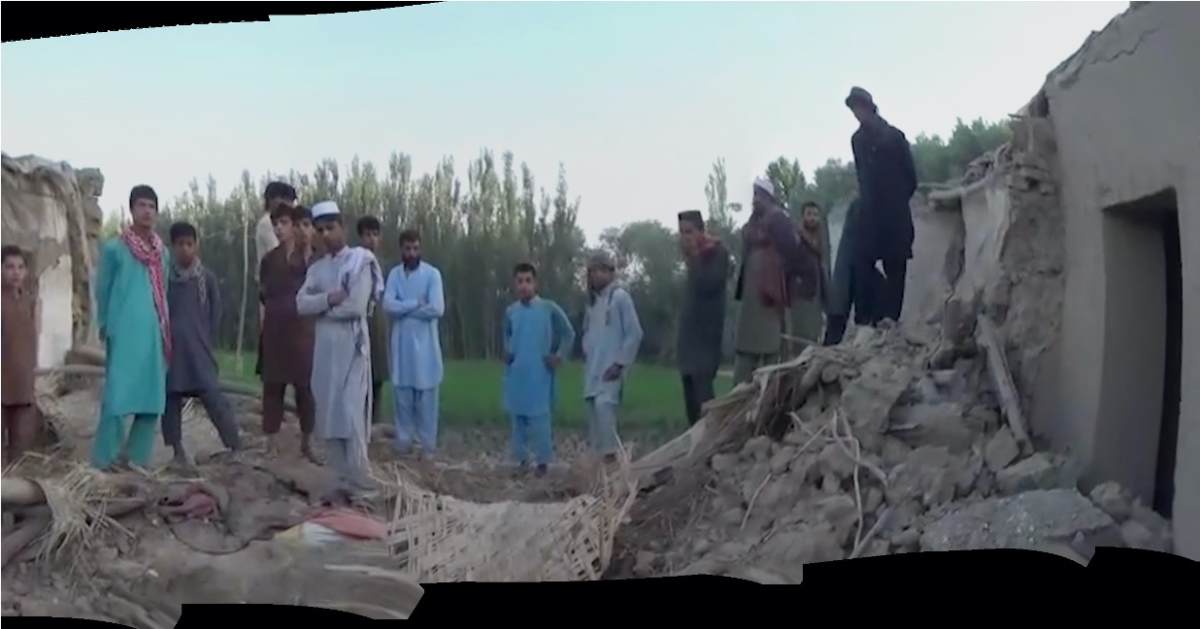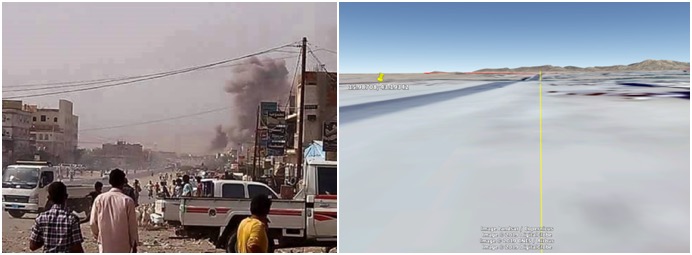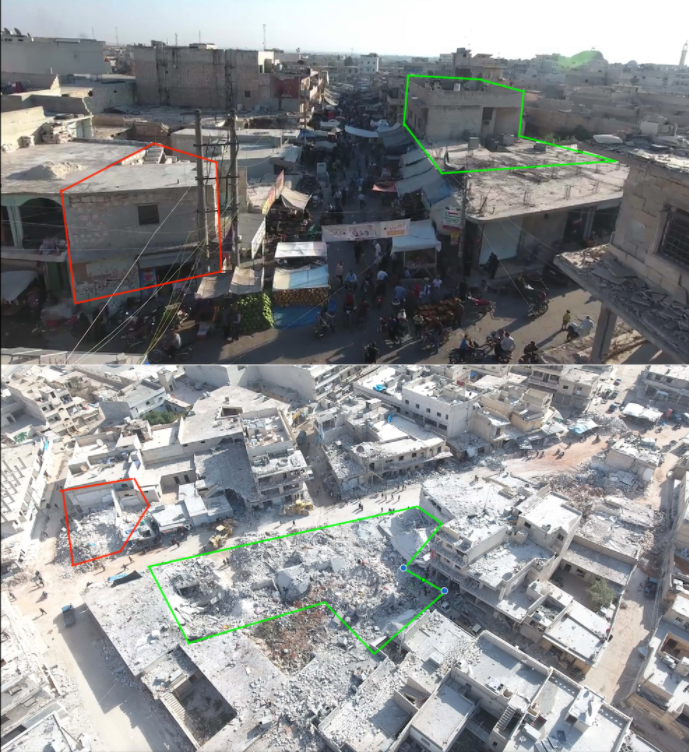The Yemen Project: ADE10001 - Fayoush Market Strike
Incident ID: ADE10001
Location: al-Fayush Livestock [goats and sheep]/Qat Market, Lahj Governorate
Co-ordinates: 12.979582, 44.937651
Incident grading: Confirmed
Date: 2015-07-06 YYYY-MM-DD
Time: 0545 AST (according to Yemeni government report) or mid-day according to the LA Times. Images from the scene appear to support the earlier time.
KEY FINDINGS
- We identified the location of the alleged strike as the al-Fayush market. Using open sources, including images, videos and satellite imagery, we confirmed the strike took place in a livestock market near to a petrol station and multiple other services, such as a Qat market and restaurant.
- Open source video and images taken after the strike show two distinct craters, supporting allegations that two munitions were dropped during this strike. It was not possible to assess if the second munition deliberately targeted people responding to the initial strike
- Several reports (Amnesty, the UN Office for the Coordination of Human Affairs) agree that the strike took place on 6th July, 2015. Key witness statements are taken and report that two airstrikes took place. Such information correlates with our findings, based on geolocational evidence and open source visual evidence that illustrates the impact and date of the strikes.
DISCOVERY PROCESS
Searches were carried out using English and Arabic variations of the name “Fayoush” combined with terms such as “airstrike”, “bombing”, “killed” etc. These search results were then narrowed-down using advanced searches on both social media and search engines which focused on the days immediately following the strike. These searches identified a large number of reports, images and videos which provided useful sources. A list of these sources can be seen below:
International Organisations
-
- A report from the UN Office for the Coordination of Human Affairs
- A report from Amnesty International
- A report (p.47 on) by The National Commission to Investigate Alleged Violations to Human Rights, a body set up by the government of the Republic of Yemen (NCIAVHR)
- A statement by Joint Incidents Assessment Team (JIAT)
English-language Media Reports
-
- Khaleej Times
- Knight Labs: Story Map
- Yemen War Archives [found via the Yemen Event Log] [includes 1 wide shot, 3 close-ups and 1 video]
- Indian Express
- The Intercept.
- Fox News
- Los Angeles Times
- BBC
- Alaraby
- DW
- Well-Informed Circles
- YNet
- Pakistan Defence [Reprint from Knight Labs – includes crater photo]
- Yemen Post
- Trend News Agency
- Hindu Times
- Trouw.
- One Last Chance.
- Associated Press
- News Tribune (AP)
- Boston Globe (AP)
- Christian Science Monitor (AP)
- Almasdan Online (AP)
Videos:
All three videos below share footage, but all include unique information.
- https://www.youtube.com/watch?v=7f2O2e7peYA Video from a channel named “The media front to confront the Saudi aggression on Yemen”, which included footage of human fatalities, dead animals, damaged property and craters. Hereafter referred to as the “Media Front” video.
- https://www.youtube.com/watch?v=H3VtEreFSqs Video from al-Masira, the Huthi channel, with footage of the dead bodies of the attack in the hospital and interviews with eyewitnesses at the site of the incident. Hereafter referred to as the “al-Masira” video.
- Yemen War Archives posted a video from 06 Jul 2015 which included clips from the above two videos and higher-quality stills from the video. Hereafter referred to as the “YWA” video.
Satellite imagery
TerraServer, a website which allows previews of satellite images, was used to view satellite images of this location. A Digital Globe satellite image taken on 08 Jun 2016 was the highest definition image available on of this area available on Google Earth Pro, and as such was used as the primary reference source. Other satellite images taken before and after the date of the alleged site were examined to ensure building work and other physical changes were observed and noted during this process.
Additional Sites
- Timelines of History, Yemen
- Yemen Event Log
- Carol Anne Grayson (Radical Sister) Blog
- http://poorworld.net/Yemen/YemenImages107.htm (images of the market)
- http://poorworld.net/Yemen/YemenImages108.htm (images of the market, and injured in hospital)
WHERE?
Where did this incident take place?
The incident took place in the livestock market (for goats & sheep) which lies next to the N1 motorway, the primary route between Aden and Lahj. The livestock market was adjacent to the al-Fayush qat market and al-Fayush gas station at the junction of the N1 and B19 roads. The market is named in a number of news and video reports as the al-Fayush livestock market. It should be noted that, according to Geonames, a geographical database, the actual village of Fayush is approximately 4 km along the B19 road to the north-east of the market place.
We understood that it is common practice in Yemen for villagers living near major motorways to set up shops on either side of that motorway, which also takes up the name of the nearest village from which the shopkeepers usually come from. Starting from the site of the actual village, we therefore searched for the potential site of the market in the areas adjacent to the N1 motorway. By examining the Media Front video we noted that a gas station by a major road and a characteristic unfinished rectangular building which is noted on google maps as “Fayyoh Mosque” and “Supermarket”, matched the structures seen in the video.
The sign of a local restaurant, called the “Shabwa Mandi and Mahbaza” is clearly visible in a photograph taken by Iona Craig for the Intercept. The same restaurant appears in the Media Front video footage. Due to this restaurant sign both the youtube video and the photograph of the crater by Iona Craig can be confidently geolocated to a building (co-ordinates: 12.980306, 44.937580) within the al-Fayush market, as the restaurant is marked on Google Maps under its Arabic name: مندي ومخبازة نعيم شبوة. [hereafter referred to as the Shabwa restaurant].

Restaurant sign, Iona Craig, Knight Labs Story Map

The same restaurant can be seen in the Media Front video
This location can be confirmed by matching features within Iona Craig’s photo to a satellite image taken on 08 June 2016, which is available on Google Earth. A minaret, marked in red, is visible in the background, while a telegraph pole, marked in green, is visible in the foreground. The restaurant identified above is marked in blue. The arrangement of these features, as well as other structures visible in this and other images, mean it is certain this is the location depicted in the videos and vast majority of the images.
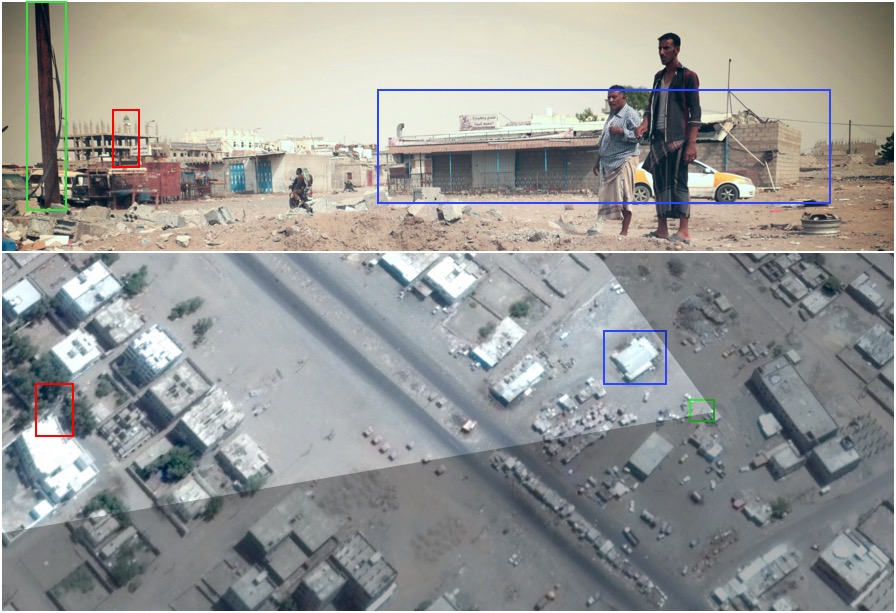
Top: Image taken by Iona Craig, (source: Knight Labs Story Map), Bottom: satellite imagery taken on 08/06/2016 (courtesy of Google /DigitalGlobe)
What was the location being used for?
As stated above, the rectangular plot of land where the incident took place is located on the corner of a major motorway (N1) which links the port city of Aden with the capital Sana’a, and a local connecting road (B19). Within that plot of land a number of commercial activities take place which cater to the needs of the local population and passing travellers. A variety of services for travellers has been marked on Google Maps: a gas station, a Qat market, several restaurants, a mosque, a grocery store and several supermarkets. These services have been reviewed by scores of users, indicating they are genuine places. Satellite imagery also shows scores of smaller stalls within the vicinity of the petrol station, likely smaller traders which are too small to justify their own Google Maps pin.

Google maps image showing services tagged at location of the Fayoush Market (accessed on 21 Feb 2019). Note the large number of restaurants and other commercial activities marked in this location, especially the gas station in the center of the image (courtesy of Google/DigitalGlobe)
The first publicly available satellite image available on Google Earth after the incident is from 15/05/2016, by which time the long rectangular building, marked as a Mosque and Supermarket, to the east of the gas station appears to have been fully built (as opposed to the videos of the incident where it is clearly half-built). By this date it appears that any damage from this strike had been repaired and the craters have been filled in. The constant and heavy usage of that particular market area make it likely this damage was repaired as quickly as possible to allow the market to continue operating.
Moreover, the Media Front and al-Masira videos of the aftermath of the attack clearly shows the gas station, the restaurant, and scores of dead goats. This corroborates information on Google Maps and is indicative of the use of that particular area as a livestock market for sheep and goats. As noted above, the image of the site taken by Iona Craig for Knight Labs Story Map clearly show the restaurant sign and its name.

Still from the Media Front video showing dead livestock

Still from the Media Front video showing the gas station to the left-hand side
Both the geolocation and imagery of the site confirm that it was a market area with a gas station, beside a main two-way road. The market area appears to continue to have been used following the 2015 attack, as demonstrated using two images below from dates before and after the strike.

Left: Before the strike. Image taken on 10/03/2014 (courtesy of Google/DigitalGlobe) – Note the large number of small stalls. Right: After the strike image taken on 15/05/2016 (courtesy of Google/DigitalGlobe) – Note that the market has continued to be used for commercial activities.
Military activity
No obvious military activity could be identified from open sources within two kilometers of the market. However, some witnesses interviewed by The National Commission to Investigate Alleged Violations to Human Rights (NCIAVHR) stated that there was military activity in the general area:
“Witness (N. F. M.)… added that there were two checkpoints manned by the Houthi and Saleh groups, and that was why the market was bombed.”
“Witness (A. S. S.)… said that, on 6.7.2015, in the area of Al Fayoosh, specifically in the livestock market, the Houthis that were manning the security checkpoint that was 200 meters from the market moved into the Al Fayoosh market and fired a Katyusha rocket into the market”
It is not clear exactly where this alleged military activity took place. It should be noted that in images from the NCIAVHR report it appears that witness statements were being taken in public and in the presence of an armed person, although it is not known who the person is or in what capacity they were operating. It should be noted that in Yemen being armed can be a regarded as a mark of status, and does not necessarily indicate that person is a combatant.

An image from the NCIAVHR report with the original caption. Note the armed man in the background.
A report from the LA Times stated that witnesses claimed “A car carrying fighters loyal to the Houthis had arrived at the market to make a purchase shortly before the attack, and at least six Houthi fighters were killed in the strike”
An Amnesty International report notes that ‘Even if some combatants had been present at the site this would not have justified launching an attack on a market, which was sure to cause large-scale civilian casualties and fatalities and which would therefore have been not only disproportionate but also indiscriminate.’ (p.6).
This area does not appear to have been targeted before.
WHEN?
Date
All sources agree this incident took place on 06 Jul 2015
Time
Different times were indicated in different reports
-
- The NCIAVHR report claims the strike took place at 0545 AST.
- The Los Angeles Times reported that the airstrike occurred at midday.
It should be noted that the extent of the casualties (both human and animal) from the reports of the incident and the videos, suggest that the attack happened during trading hours. Traditionally in Yemen noon is the part the day that people have finished with their midday prayers and congregate in the market place to purchase their lunch and qat supplies for their afternoon gatherings. At 0545 AST in the morning traders would be beginning to set up in the market after the first prayers of the day. Therefore it is possible that the strike could have taken place at either time.
The image below, which was posted at 1340 AST on the 06/07/2015, the day of the strike, appears to have been taken shortly after the strike took place. This appears to be the case for several reasons:
1. A person can be seen covering a body part with a piece of cardboard.
2. More tellingly, the shadow of the partially completed mosque is falling from the east and appears to be, very approximately, over 5 meters in length. The direction and length of this shadow means this image must have been taken in the morning, likely some time before 0800. This can be checked by using SunCalc.org, a free tool designed to allow photographers to measure Sun angle and shadows.

Top: the image which appears to have been taken in the morning, Bottom: a still from the Media Front video. A distinctive piece of blue and red debris (marked in yellow) and a wheel rim (marked in red) can be seen in both the image. Multiple other details match when compared with other images and videos of the strike.

Another image posted by the Yemen Post newspaper also what appears to be a casualty in a long shadow, indicating it may have been taken in the morning. The lighter patches where light has shone through appear to match those in the image above. However, due to the lack of other details within the image it is not possible to geolocate this image exactly and identify which direction the shadows are coming from.
Therefore, despite there being disagreement over exactly what time this incident took place, media posted on the day of the event indicate it happened while shadows were long and coming from the east, supporting the earlier time of 0545 AST.
WHAT HAPPENED?
– The video highlights that both human beings and animals (mainly goats and sheep) were killed or severely injured in the attacks.
– The UN OHCA claims: ‘Many of the victims were blown apart in the blast and have remained unidentifiable and unclaimed.’ and ‘In all, at least 41 people were killed and another 23 injured in the attack.’ (p.9). See below for varying casualty claims and their sources.
– There is no indication in open sources of people who could have been characterised as military, members of tribal militia, or generally combatants. There do not appear to be weapons present in either the video reports or the photographs.
– Because the site of the attack is next to a main road, and because traders would have transported their animals, qat and other goods to the marketplace, a variety of vehicles are included in the images; trucks, SUVs, etc.
Was it an airstrike?
The contextual evidence and multiple eyewitness statements describing planes overhead indicate this was indeed an airstrike.
The Craters
– Images of the two craters show that they are relatively large, and consistent with a large munition that fell from above, penetrated the earth and then detonated. (Investigator No. 0304)
– According to the report from Amnesty International, no remains of any munitions were found from the bomb but the crater – some three meters deep and four meters in diameter – likely indicates a 500- 1,000 lbs (200 – 450 +Kg) bomb (similar to the ones used by the coalition in many other attacks). Report (p.15).
– Images taken by Iona Craig after the incident appear to be consistent with these claims.

Note the size of the crater compared to the car (Image courtesy of Iona Craig/The Intercept)
Number of craters
Videos and images from the market appear to show that there are two distinct craters. This can been seen in the Media Front video at 00:34, where the camera zooms from one crater to the other The first crater (Crater 1) is immediately next to a light-coloured car with a buckled roof and raised bonnet, and to the east of the Shabwa restaurant. It is depicted from several angles in the Media Front video, and although the crater is not always clear, the same light-coloured car can be used as a marker. In the images below the distinctive damage to the car is marked with arrows, while Crater 1 is marked by a yellow circle. The top image is a composite panorama created by stitching two screenshots together.

Stills from Media Front video
The second crater (Crater 2) is approximately 20 meters to the south and five meters east of Crater 1, near a large wooden pole, which appears to be a telegraph pole. The Shabwa restaurant is also visible in the background of this image, but from a slightly different angle than the images depicting Crater 1.

(Courtesy of Iona Craig, Knight Labs Story Map)
We can establish that Crater 1 and Crater 2 are different craters by examining them in detail and establishing their exact locations. Although the video depicting Crater 1 is low quality, we can see that Crater 2 has a significant amount of rubble and debris around the rim, while Crater 1 does not. Although there is a possibility that this debris could have been added or removed later, we can also identify that Crater 1 and Crater 2 are actually in different locations.
By adapting a technique called “intersection” we can identify where these craters are located within the market. In this technique, a line is drawn between two aligning known points, with the observer standing at some point along that line. Exactly where on that line the observer is standing is determined by a feature that meets that line, such as a road, ridge, or in the case of Crater 2, a wooden pole. Alternatively a second line can be drawn between a second set of aligning known points, and where the two lines meet is where the observer is standing.
In the image below we can identify certain features in an image taken of Crater 2 (top) and a Google Earth satellite image taken on 08 Jun 2016 (bottom). These include the minaret of a mosque marked in yellow, an unfinished building in blue, the Shabwa restaurant, and several telegraph poles, which can be identified in the satellite imagery from their distinctive shadows. These features can be used to establish the location of the craters.

Top image: courtesy of Iona Craig, Knight Labs Story Map. Bottom image: courtesy of Google Earth/DigitalGlobe
Crater 1 location
In the image below, the yellow line is drawn from the minaret through the third pillar from right of the incomplete building. The red line is drawn from a distinctive roof structure through the closest corner of the Shabwa restaurant. Where those lines intersect is where the camera was located. Therefore Crater 1 is located within the green circle.

Top: composite image from Media Front video, Bottom: Google Earth Imagery (courtesy of Google/DigitalGlobe)
Crater 2 location
In the image below, a yellow line is drawn through the southernmost point of the unfinished building to the telegraph pole. A red line marks the easternmost line where the camera could be: any further east and the north-eastern wall of the Shabwa restaurant (marked in purple) would not be visible. Therefore Crater 2 is within the green circle.

Top image: courtesy of Iona Craig, Knight Labs Story Map. Bottom image: courtesy of Google Earth/DigitalGlobe
In the image below, we can therefore show the location of the two craters. This analysis supports reports that the market was hit by two munitions.
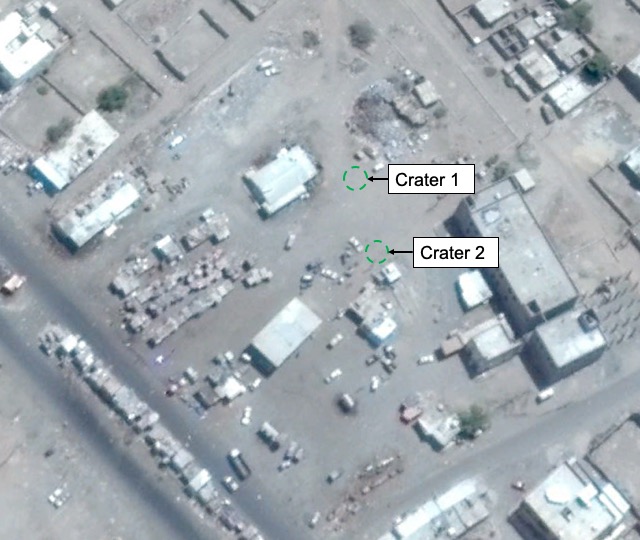
Courtesy of Google/DigitalGlobe
Casualties
The casualty count for this strike varies. A list of different claims and their sources are below:
- Amnesty International, Some 40 people killed. Scores of injured.
- OHCA, At least 41 people killed.
- Khaleej Times, Over 45 civilians killed. Over 50 civilians wounded.
- Knight Labs: Story Map, At least 35 killed.
- Yemen War Archives, Over 40 people killed. Many others injured.
- Indian Express, Over 45 killed.
- The Intercept, Correspondant reported that at least 35 killed. Interviewee stated that over 50 were killed.
- Fox News, Over 45 killed. Over 50 wounded.
- Los Angeles Times. At least 50 killed. At least 6 Houthi fighters killed.
- Alaraby. Over 40 killed.
- DW, At least 41 people, most of them civilians, Dozens wounded.
- Well-Informed Circles, At least 45 dead.
- YNet, Over 45 killed. Over 50 wounded [Reprint].
- Yemen Post, Around 50 civilians killed.
- Trend News Agency, Over 45 civilians killed. Over 50 civilians wounded [Reprint].
- Hindu Times, Over 45 civilians killed. Over 50 civilians wounded [Reprint].
- Trouw. Over 45 civilians killed. Over 50 civilians wounded
- One Last Chance. 35 killed
In summary: Minimum reported fatalities: 35. Maximum reported fatalities: 50.
STATEMENTS FROM PARTIES TO CONFLICT
- The Yemeni Government’s National Commission to Investigate Alleged Violations to Human Rights Aden issued a Preliminary Report on Alleged Violations to Human Rights in the Republic of Yemen. Their statement about the Fayoosh Market strike can be found at pg. 47.
- The JIAT stated that “the JIST [sic] has investigated the facts and circumstances of the incident, and found that the mentioned market was not bombed, and the coalition forces bombed two sites in the same referred date, the first is: gathering of militia armed Huthi, distanced 7 km northwest away from the market, and the second is: a command building of the militia of al-Huthi, distanced 10 km north away from the market, noting that the above-mentioned sites are military goals, in accordance to the rules of engagement and international humanitarian law, as JIST [sic] found that the cattle market was not bombed by coalition forces, and was not affected by the accidental bombing of targets in the region.”
ALLEGATIONS OF “DOUBLE TAP” AIRSTRIKE
Multiple reports, and our own analysis, indicate that two munitions were dropped. There are claims that the second muntion injured and killed people helping casualties from the first incident. This is consistent with our analysis showing the two craters were within several meters of each other. It cannot be established using open sources whether those responding to the first detonation were the target of the second munition.
– Knight Labs: Story Map: “AbdulHamid Mohammed Saleh, 30, was standing on the opposite side of the road when the first missile hit the gathering of 100 men, who were there to trade goats and sheep. The initial blast killed around a dozen me, with scores more injured …. The second strike landed less than 40 yards from him, sending shrapnel flying into his back.”
– The Intercept, “Of particular concern are the U.S.-style “double tap” strikes — where follow-up strikes hit those coming to rescue victims of an initial missile attack — which became a notorious trademark of covert CIA drone strikes in Pakistan. On July 6, for instance, at least 35 rescuers and bystanders were killed trying to help scores of traders hit in a strike five minutes earlier on a farmers market in Fayoush, in Yemen’s Lahj province.”
– One Last Chance. “A favored practice is the “double tap” tactic inspired by CIA drone attacks in Pakistan: A few minutes after a first air raid, a target is bombarded a second time in order to kill the rescue forces coming to help. On July 6 alone last year, 35 people were killed in this despicable manner in Fayoush, in the Lahj province.
– Preliminary Report on Alleged Violations to Human Rights in the Republic of Yemen, the Commission did not make any conclusions about this being double-tap strike, but they did report that ‘two rockets struck the market’
Conclusion
On 6th July 2015, likely at around 0545 AST, what appears to have been an airstrike took place on the al-Fayush market which was likely full of civilians at the time. Although the presence of Houthi soldiers was mentioned by some witnesses, their presence could not be confirmed. Two munitions were dropped during this strike, and it appears to be a strong possibility the second munition may have killed and injured some of those trying to help the victims of the first. Overall, there was significant loss of civilian life, with reports ranging from 35 to 50 fatalities.
